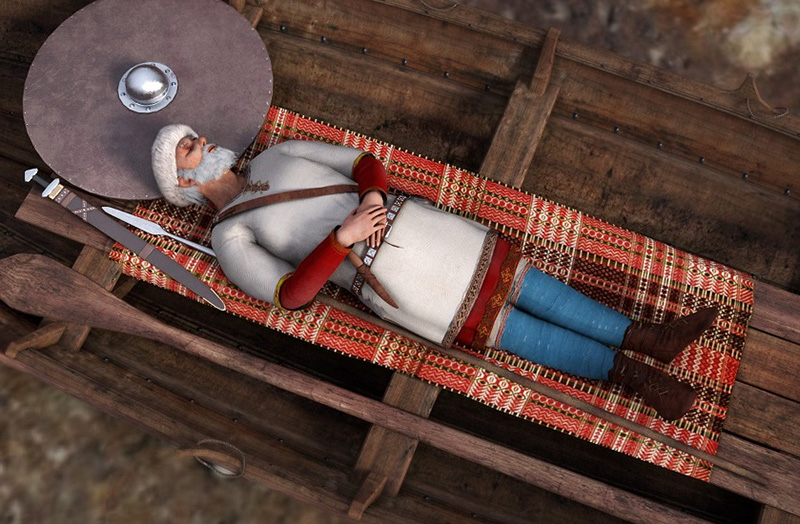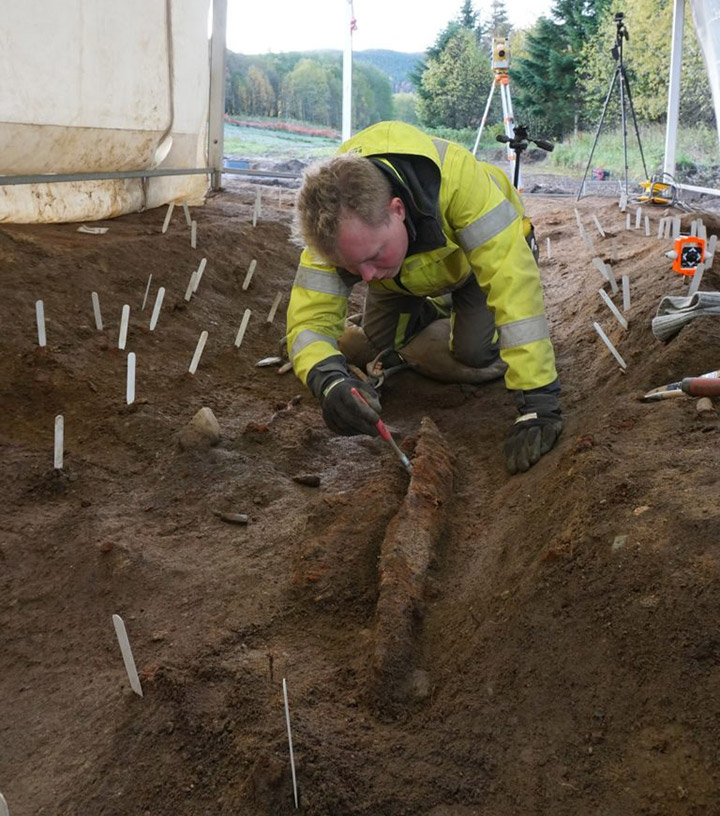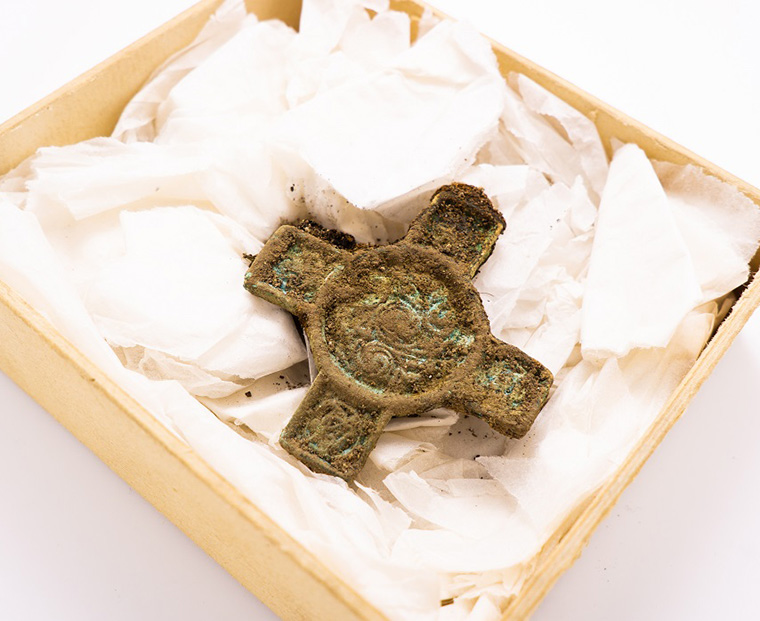
Archaeologists have uncovered a viking grave with two bodies in two boats, buried one hundred years apart. Who were they, and why were they buried together?
The unusual discovery at Vinjeøra in central Norway has been described as “a very exciting find” by archaeologists from NTNU Science Museum. Two bodies were buried in two separate boats, one on top of the other, but 100 years apart. Archaeologists have some ideas, but are hoping to find out more answers as research continues.
A team from the museum had been conducting an excavation of a known burial field of a Viking Age farm in connection with road improvements to the E39.
By law, any potential cultural heritage must be considered in relation to new construction projects. Experts have long known there had been a Viking settlement at Vinjeøra. Earlier this year, a burial house was discovered on the same site.
A fascinating question from more than 1,000 years ago
The team of archaeologists have put together the story as follows:
Some time around 850-900, a woman of standing died on a farm. Today that farm is known as Skeiet at Vinjeøra, in the southwest of Trøndelag between Trondheim and Molde. The dead woman's clothes were fastened with a bronze-plated bowl-shaped buckle and a cross-shaped buckle from a harness made in Ireland.
As is common with Viking funerals, the body was placed in a boat of about seven to eight meters in length. She was given objects to accompany her on her journey to the afterlife, including a pearl necklace, scissors, a spinning wheel, and even the head of a cow.
Two boats, one grave
There's nothing unusual so far, but what happens next has aroused many questions among archaeologists and historians. A new grave wasn't dug for the boat. Instead, an existing grave from the 8th century was excavated. This boat was larger by a couple of metres, and is home to the remains of a man and weapons.

The woman's boat was laid down on top of the man's boat in the original grave and covered once again. Who the two people were and why they were buried together even though they died around 100 years a part is a real mystery.
Read more: A Viking Timeline: What Happened & When?
“I had heard about burial mounds with several boat graves, but never a boat that has been buried in another boat,” said archeologist Raymond Sauvage to Gemini. “I since learned that in the 1950s a few double boat tombs were found in Vestfold, but we can still say that this is an unknown phenomenon.”
Human remains also found
The wood from the boats had long since rotted away, with just a little remaining in the keel on the smaller boat. However, the nails lay where they originally had been. By looking at the rivets, archaeologists could clearly see they had found different two boats in one grave.
Read more: Second Viking grave found on Norwegian island
What surprised the team just as much as the original discovery was the discovery of parts of the woman's skull in the upper boat. That's because the soil in the excavation area was poor and preserved remains were not expected to be found.
Sauvage said that they hope it will be possible to extract DNA from the skull. If so, it should be possible to learn more about what the woman looked like. However, strict regulations on human bone research means that permission will have to be sought first. Isotope analysis may also reveal things like where a person was born and lived, and what they ate.
An Irish connection
The cross-shaped buckle found in the woman's grave reveals a lot about the woman and her community. The design and decoration reveals its Irish origin, and that it was once part of a harness.

“It was common for the Vikings to split such decorative harness fittings and reuse them as costume jewellery,” said researcher Aina Heen Pettersen from NTNU's Department of Historical Studies. She specialises in Irish and English objects brought to Norway during the Viking Age.
Such buckles were likely an exclusive form of costume decoration. They are often found in burial sites, which indicates the seizures were distributed among participants in looting or trading trips. Because these voyages were of such importance to the culture, participation was important and often raised the status of a family.
Read more: Life in Norway's Viking Blog
“Incorporating objects from these journeys as costume jewellery signaled a clear distinction between those who belonged to the segment of the population who traveled out and “the others” in the local community,” explained Pettersen.
Were they related?
The man buried in the original large boat was accompanied with spears, shields and swords. Weapon styles changed over the years, so archaeologists are confident in their dating of the grave to the 8th century. But what was the connection between the two people?
The obvious answer is that they were related. Vikings who lived at Vinjeøra likely knew who was buried in which mound. This is because in the society of the time, family was important to mark status but also to consolidate property rights. If there was any doubt around these, rights could be traced back via burial mounds.
“With the backdrop, one can imagine that the two were buried together to mark the relative's ownership of the farm,” said Sauvage.


Hi David! My grandfather was originally from Trondheim. He left Norway as a young man I believe in 1919 and came here to the U.S. I’m interested in learning more about Norway, particularly Trondheim, and any suggestions would be appreciated. Thanks!
Norway has digitized a lot of records which can be seen online. Birth, conformation, marriage, death, census and emigration. All you need is name, county and birthdate to search.
Bobby Fears – A couple of good places for you to start: https://vesterheim.org/ & http://www.nagcnl.org/ The first one is The National Norwegian American Museum and Heritage Center, the second one is Norwegian American Genealogy Center. You might even find a Sons of Norway Lodge close to where you live. https://www.sofn.com/
Land was hard to find in Norway so it makes sense that they would “double up” the burials. It was a space saving measure.
Nope, there are plenty of area to put the burials on. The graves in viking age Scandinavia were not put in the arable land, but even i areas with plenty of arable land, there are also plenty of small hills or forests scattered bascially everywhere, even close to the farms – and on these areas (plentyful!) the graves were put. Lack of land is not in any way an explanation for this. /archaeologist, specialized in the viking age and excavated plenty of viking age graves
I believe this is true. Vikings were always looking for new farm land because farmable land was getting scarce. I know doubling up on graves are done to this day in Norway, if you don’t pay a maintenance fee on a loved ones grave, they’ll sell the occupied grave and bury someone on top of you (loved one). I witnessed this in Mexico, my mother inlaw, who was born and raised in Mexico, is buried on top of five other human remains, she is incased in cement, level on the ground.
It’s extremely rare for for one one Viking ship to be built on top of another. Irish did marry Viking. I have Viking DNA. Vikings were into marrying women of conquered lands. They appreciateed their wives and their culture.
Christine Spielman
I, too, have the Irish/Viking DNA combo. However, I wouldn’t call it ‘marrying’, necessarily. The Vikings engaged in slaving and Dublin was a major slave market. They didn’t bring slavery to Ireland, it was active before they arrived, just to be clear.
It seems to me that it was a family burial plot – very typical of our recent culture -,to be close to your family members.
Many churchyards have headstones close together often spanning several generations. I suppose DNA testing is not an option in the case.
Could’ve been grand daughter or daughter
During the winter the ground would be too hard to dig. Maybe a previous dig would not be as hard and frozen? Does anyone know how burials were handled in the dead of winter?
Knowing if a person has the DNA of these two would truly be exciting. My ancestors all came from the island of Smola and Surnadal. Possible DNA? Perhaps!
“Appropriated” is more in line with practices than “appreciateed”
Does anybody know how I could trace my Danish/Swedish ancestry? its a bit complicated for I live in the UK, My mother was English and my father was born of a Swedish mother and Danish father in 1919. My father’s family emigrated to New Brunswick Canada around 1928. he sadly died in 1954.